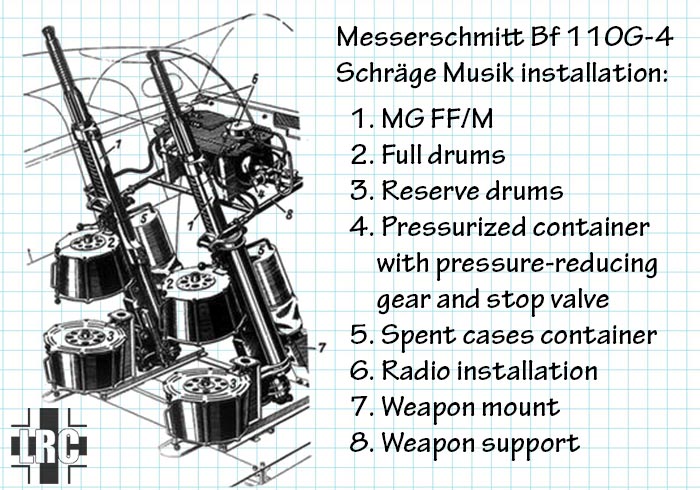Messerschmitt BF 110
Night Fighters
After a period of use on bombing and reconnaissance, the type found its niche during the winter of 1940-41 as
a night fighter defending Hitler's Reich. At first the three main crew members had no special equipment for
night operations and relied on their eyes alone to find enemy aircraft in the dark. Ground-controlled
interception began from mid 1941 and the 110 began to take its toll on RAF bombers and was soon an aircraft
to be feared. Airborne radar was used experimentally during 1941, effective up to a maximum distance of
3.5 km/ 2.2 miles and capable of bringing the 110 to within 200m/655ft of a target.
The Bf 110 would be the backbone of the Nachtjagdgeschwader throughout the war. The first units undertook
defence operations over Germany as early as the autumn of 1940. Opposition was light until 1942, when British
heavy bombers started to appear.
One of the most notable actions of the Bf 110 occurred on the night of the 17/18 August 1943. Some Bf 110
units had been equipped with the experimental Schräge Musik system, an emplacement of two upward-firing
cannon, which for its initial installations placed the twin-cannon fitment almost midway down the cockpit
canopy behind the pilot, which could attack the blind spot of RAF Bomber Command's Lancaster and Halifax
bombers, which lacked a ventral turret. Using this, NJG 5's Leutnant Peter Erhardt destroyed four bombers
in 30 minutes. Despite excellent visibility, none of the RAF bombers had reported anything unusual
that would indicate a new weapon or tactics in the German night fighter force. This ignorance was
compounded by the tracerless ammunition used by the Bf 110s, as well as firing on the British bombers
blind spots. Many RAF crews witnessed a sudden explosion of a friendly aircraft, but assumed, in some
cases, it was very accurate flak. Few of the German fighters were seen, let alone fired on. Later on,
as the specialist Bf 110G-4s were received by night fighter wings, the mid-cockpit mount was replaced
by one at the extreme rear of the cabin.

Messerschmitt Bf 110G-4 Schräge Musik installation.
In September 1943, Arthur Harris, convinced that a strategic bombing campaign against Germany's cities would
force a German collapse, pressed for further mass attacks. While RAF Bomber Command destroyed Hannover's city
centre and 86% of crews dropped their bombs within 5 km (3 mi) of the aiming point, losses were severe. The
Ruhr Area was the prime target for British bombers in 1943, and German defences inflicted a considerable
loss rate. The Bf 110 had a hand in the destruction of some 2,751 RAF bombers in 1943, along with German
flak and other night fighters. Later, the RAF developed a radar countermeasure; Window, to blind
German radar and introduced de Havilland Mosquitos to fly feints and divert the Bf 110s and other night
fighter forces from their true target, which worked, initially. At this time, the Bf 110 remained the
backbone of the night force, although it was now being reinforced by the Junkers Ju 88. In October
1943, General Josef Kammhuber reported the climbing attrition rate as "unacceptable", and urged Hermann
Göring to stop committing the German night fighters to daylight operations. Many Nachtjagdgeschwader
had taken part in costly daylight battles of attrition. From June–August, it had increased from around
2% to 9.8%. However the fortunes for the mostly Bf 110 equipped force turned during late
August/September 1943. The night fighter arm claimed the destruction of 123 out of some 1,179 bombers
over Hamburg on one night; a 7.2% loss rate.
During the Battle of Berlin, 1,128 bombers were lost in
five months. RAF Bomber Command had "nearly burned out". These losses were primarily a result
of fighter defences, at the heart of which was the Bf 110. The German defences had won a victory
which prevented deep penetration raids for a time. But Luftwaffe losses were high; 15% of crews
were killed in the first three months of 1944.
Most of the German night fighter aces flew the Bf 110 at some point during their combat careers, and the top
night fighter ace of all time, Major Heinz-Wolfgang Schnaufer, flew it exclusively and claimed 121 victories
in 164 combat missions.

Messerschmitt Bf 110G-4 Schräge Musik installation.
Sources:
Gunston, Bill - The Encyclodepia of the Worlds Combat aircraft, 1976, Chartwell Books, Inc., New York
Brown, Eric, Captain - Wings of the Luftwaffe , 1979, Airlife Publishing Ltd., Shrewsbury
, 1979, Airlife Publishing Ltd., Shrewsbury
Gunston, Bill & Wood, Tony - Hitler's Luftwaffe , 1977, Salamander
Books Ltd., London
, 1977, Salamander
Books Ltd., London
Donald, David - The Complete Encyclopedia Of World Aircraft, 1997, Brown Packaging Books Ltd., London
Wikipedia - BF 110
Gunston, Bill - The Encyclodepia of the Worlds Combat aircraft, 1976, Chartwell Books, Inc., New York
Brown, Eric, Captain - Wings of the Luftwaffe
Gunston, Bill & Wood, Tony - Hitler's Luftwaffe
Donald, David - The Complete Encyclopedia Of World Aircraft, 1997, Brown Packaging Books Ltd., London
Wikipedia - BF 110





